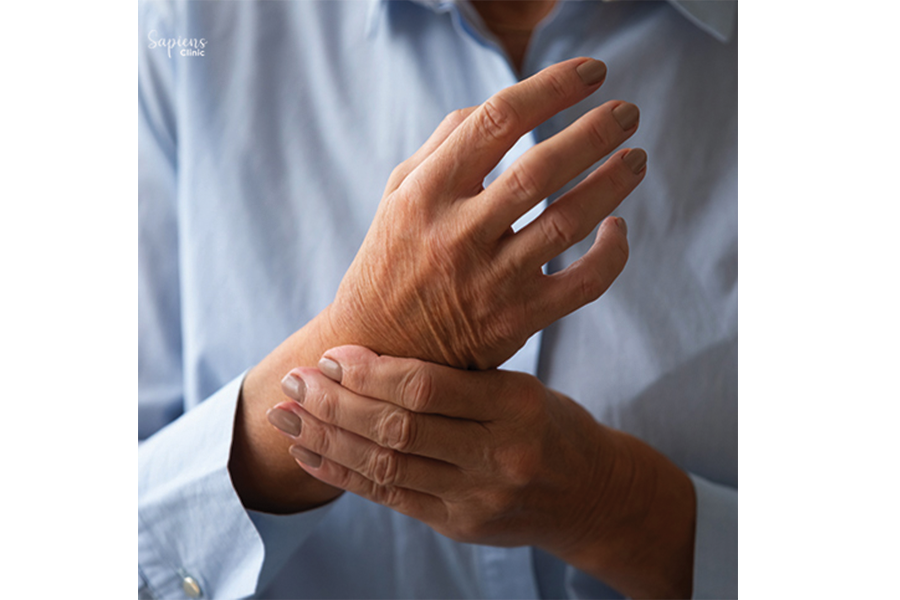Arthritis Treatment for Fingers, Wrist and Elbow in Malleshwaram
Arthritis affecting the fingers, wrist, and elbow can significantly impair daily activities, causing pain, stiffness, and reduced mobility. At Sapiens Clinic in Malleshwaram, we specialize in diagnosing and managing various forms of arthritis to help patients regain function and improve quality of life.
Understanding Arthritis in the Upper Limb
Arthritis is the inflammation of one or more joints, leading to pain and stiffness. In the upper limb, the most commonly affected joints include :
- Fingers: Distal interphalangeal (DIP), proximal interphalangeal (PIP), and metacarpophalangeal (MCP) joints.
- Wrist: Radiocarpal and intercarpal joints.
- Elbow: Humeroulnar and humeroradial joints.
Common types of arthritis affecting these areas are :
- Osteoarthritis (OA): Degenerative joint disease causing cartilage breakdown.
- Rheumatoid Arthritis (RA): An autoimmune disorder leading to joint inflammation.
- Psoriatic Arthritis: Associated with psoriasis, affecting joints and skin.
Symptoms
Symptoms vary depending on the type and severity of arthritis but commonly include :
- Joint pain and tenderness
- Swelling and warmth around the joints
- Stiffness, especially in the morning or after inactivity
- Reduced range of motion
- Visible joint deformities in advanced cases
Diagnosis
Accurate diagnosis is crucial for effective treatment. Diagnostic methods include :
- Medical History and Physical Examination: Assessing symptoms and joint function.
- Imaging Tests: X-rays to detect joint damage; MRI or ultrasound for detailed images.
- Laboratory Tests: Blood tests to identify markers of inflammation or autoimmune activity.
Treatment Options
Treatment aims to relieve symptoms and improve joint function :
Non-Surgical Treatments
- Medications:
- NSAIDs: Reduce pain and inflammation.
- DMARDs: Slow disease progression in RA.
- Corticosteroids: Control acute flare-ups.
- Physical and Occupational Therapy: Exercises to strengthen muscles and improve flexibility.
- Splints and Braces: Support joints and reduce strain.
- Lifestyle Modifications: Weight management and activity adjustments.
Surgical Treatments
Considered when conservative treatments fail :
- Joint Replacement (Arthroplasty): Replacing damaged joints with prosthetics.
- Joint Fusion (Arthrodesis): Fusing bones to eliminate painful movement.
- Synovectomy: Removing inflamed joint lining.
Prevention and Management
While some risk factors like age and genetics can’t be changed, certain measures can help :
- Regular low-impact exercise
- Healthy diet rich in anti-inflammatory foods
- Avoiding joint overuse
- Prompt treatment of joint injuries
Conclusion
Early diagnosis and a comprehensive treatment plan are key to managing arthritis effectively. If you’re experiencing joint pain or stiffness in your fingers, wrist, or elbow, consult Dr. Darshan Kumar A. Jain, Orthopedic Specialist at Sapiens Clinic, Malleshwaram, for a personalized evaluation and treatment strategy.
FAQs
1. What causes arthritis in the upper limbs?
Causes include wear and tear (osteoarthritis), autoimmune responses (rheumatoid arthritis), and genetic factors.
2. Can arthritis be cured?
While there’s no cure, treatments can effectively manage symptoms and improve quality of life.
3. When is surgery necessary for arthritis?
Surgery is considered when conservative treatments fail to relieve symptoms or when joint damage is severe.
4. Are there lifestyle changes that can help?
Yes, regular exercise, a healthy diet, and avoiding joint overuse can help manage symptoms.
5. How can I prevent arthritis progression?
Early diagnosis, adherence to treatment plans, and lifestyle modifications can slow disease progression.

Leave a Reply